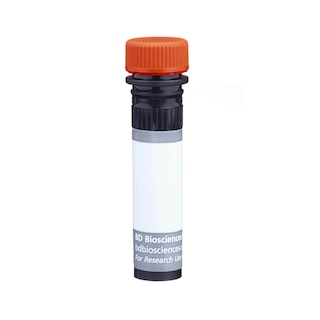-
Your selected country is
Middle East / Africa
- Change country/language
Old Browser
This page has been recently translated and is available in French now.
Looks like you're visiting us from {countryName}.
Would you like to stay on the current country site or be switched to your country?


Regulatory Status Legend
Any use of products other than the permitted use without the express written authorization of Becton, Dickinson and Company is strictly prohibited.
Preparation And Storage
Recommended Assay Procedures
For optimal and reproducible results, BD Horizon Brilliant Stain Buffer should be used anytime two or more BD Horizon Brilliant dyes (including BD OptiBuild Brilliant reagents) are used in the same experiment. Fluorescent dye interactions may cause staining artifacts which may affect data interpretation. The BD Horizon Brilliant Stain Buffer was designed to minimize these interactions. More information can be found in the Technical Data Sheet of the BD Horizon Brilliant Stain Buffer (Cat. No. 563794).
Product Notices
- This antibody was developed for use in flow cytometry.
- The production process underwent stringent testing and validation to assure that it generates a high-quality conjugate with consistent performance and specific binding activity. However, verification testing has not been performed on all conjugate lots.
- Researchers should determine the optimal concentration of this reagent for their individual applications.
- An isotype control should be used at the same concentration as the antibody of interest.
- Caution: Sodium azide yields highly toxic hydrazoic acid under acidic conditions. Dilute azide compounds in running water before discarding to avoid accumulation of potentially explosive deposits in plumbing.
- For fluorochrome spectra and suitable instrument settings, please refer to our Multicolor Flow Cytometry web page at www.bdbiosciences.com/colors.
- Please refer to www.bdbiosciences.com/us/s/resources for technical protocols.
- BD Horizon Brilliant Stain Buffer is covered by one or more of the following US patents: 8,110,673; 8,158,444; 8,575,303; 8,354,239.
- BD Horizon Brilliant Ultraviolet 737 is covered by one or more of the following US patents: 8,110,673; 8,158,444; 8,227,187; 8,575,303; 8,354,239.
- Alexa Fluor® is a registered trademark of Life Technologies Corporation.
Companion Products






The monoclonal antibody 4B12/CCR7 reacts with the mouse C-C chemokine receptor type 7 (CCR7). CCR7 is also known as CD197 (previously known as EBI1, Ebi1h and CMKBR7) and plays a central role in mediating homeostatic B and T lymphocyte trafficking to and within secondary lymphoid tissues. CD197 is a seven-transmembrane, G-protein-coupled, 43 kDa glycoprotein receptor that is specific for the CC chemokines, MIP3ß/Exodus-3/ELC/CKb11/Scya19/CCL19 and 6Ckine/Exodus-2/SLC/TCA4/CKb9/Scya21/CCL21. The mouse Ccr7 gene is located on chromosome 11. CD197 (CCR7) is differentially expressed by subsets of thymocytes. Positive CD197 expression appears to be involved in the cortex-to-medulla migration of positively-selected thymocytes wherein they complete functional maturation including the establishment of central tolerance. It is most highly expressed by some mature medullary single-positive thymocytes. CD197 is also expressed by subsets of mature peripheral CD4+ and CD8+ T lymphocytes including naïve and regulatory T cells and central memory T cells. In addition, it is differentially expressed by subsets of B lymphocytes, dendritic cells, and Langerhans cells. CD197 serves as a homing receptor that helps guide these various cell types to and within lymphoid tissues. In this way, CCR7 supports protective immunity while safeguarding self tolerance. Reportedly, the 4B12/CCR7 antibody is not agonistic, is not blocked by CCL21 nor by physiologic levels of CCL19, nor does the antibody block the binding of CCL21 to CCR7. The immunogen used to generate the 4B12 hybridoma was a mouse CCR7-transfected rat cell line.
The antibody was conjugated to BD Horizon™ BUV737 which is part of the BD Horizon Brilliant™ Ultraviolet family of dyes. This dye is a tandem fluorochrome of BD Horizon BUV395 with an Ex Max of 348-nm and an acceptor dye with an Em Max at 737-nm. BD Horizon Brilliant BUV737 can be excited by the ultraviolet laser (355 nm) and detected with a 740/35 filter. Due to the excitation of the acceptor dye by other laser lines, there may be significant spillover into channels detecting Alexa Fluor® 700-like dyes (eg, 712/20-nm filter).
Due to spectral differences between labeled cells and beads, using BD™ CompBeads can result in incorrect spillover values when used with BD Horizon BUV737 reagents. Therefore, the use of BD CompBeads or BD CompBeads Plus to determine spillover values for these reagents is not recommended. Different BUV737 reagents (eg, CD4 vs. CD45) can have slightly different fluorescence spillover therefore, it may also be necessary to use clone specific compensation controls when using these reagents.

Development References (5)
-
Britschgi MR, Link A, Lissandrin TK, Luther SA. Dynamic modulation of CCR7 expression and function on naive T lymphocytes in vivo. J Immunol. 2008; 181(11):7681-7688. (Clone-specific: Flow cytometry). View Reference
-
Forster R, Davalos-Misslitz AC, Rot A. CCR7 and its ligands: balancing immunity and tolerance. Nat Rev Immunol. 2008; 8(5):362-371. (Biology). View Reference
-
Kurobe, H., Liu, et al. CCR7-dependent cortex-to-medulla migration of positively selected thymocytes is essential for establishing central tolerance. Immunity. 2006; 24(2):165-177. (Biology). View Reference
-
Ohl L, Mohaupt M, Czeloth N, et al. CCR7 governs skin dendritic cell migration under inflammatory and steady-state conditions. Immunity. 2004; 21(2):279-288. (Clone-specific: Flow cytometry, Immunofluorescence, Immunoprecipitation, Neutralization). View Reference
-
Schweickart VL, Raport CJ, Godiska R, et al. Cloning of human and mouse EBI1, a lymphoid-specific G-protein-coupled receptor encoded on human chromosome 17q12-q21.2. Genomics. 1994; 23(3):643-650. (Biology). View Reference
Please refer to Support Documents for Quality Certificates
Global - Refer to manufacturer's instructions for use and related User Manuals and Technical data sheets before using this products as described
Comparisons, where applicable, are made against older BD Technology, manual methods or are general performance claims. Comparisons are not made against non-BD technologies, unless otherwise noted.
For Research Use Only. Not for use in diagnostic or therapeutic procedures.
Report a Site Issue
This form is intended to help us improve our website experience. For other support, please visit our Contact Us page.